 |

|
Underwater Explorer
 Interview with Dr. Robert Ballard
President of the Institute for Exploration
Mystic, Connecticut
NOVA: What have been the advances in technology that have made all these
underwater discoveries possible?
BB: It's the advent of sophisticated search systems. It's the development of
robotics, the fiber optics, earth orbiting satellites. There's a long list of
technologies that have now made it possible to carry out very precise search
efforts in the deep sea.
NOVA: Can you talk a little bit about your background and how you came to be
interested in all this?
BB: Well, when I was a kid, I grew up in San Diego next to the ocean. The
ocean was my friend—my best friend. And I wanted to be the first kid to put
footprints on the sand after a tide. I loved the story of Robinson Crusoe,
walking this deserted beach, finding treasures that had been washed up. And
every 12 hours the tidal pool changed—a different set of animals got
trapped. You might find one that had a crab that would fight to its death to
stop you from picking it up. Or sea anemones, where you would just touch them
and they would close up. And so tidal pools were the microcosm that I was an
explorer of. And I've never grown up. I mean I still have that childish
desire to poke around.
NOVA: And your education? What did you pursue?
BB: My education was in science, in technology and in the military—because
most explorers have some military connection. And so I'm a Commander in the
United States Navy, still in the Reserve. I also went off and got a Ph.D. in
marine geology and geophysics, which is mapping. And then I also developed a
strong interest in submarines and diving technology. So it's all in the
context of an epic journey—to go forth with a dream and assemble your team
and overcome the elements and find the truth and try and share it.
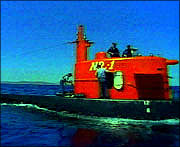 NOVA: The sonar technology on the Navy NR-1 nuclear submarine... NOVA: The sonar technology on the Navy NR-1 nuclear submarine...
BB: Unbelievable.
NOVA: Was it more powerful than sonar you've used in the past?
BB: Oh, more powerful than I've ever had. It was developed during the Cold
War for taking nuclear submarines under the ice cap in search of Russian
submarines. And so it's a very advanced sonar that was designed to look up.
And what they've done is simply rotated it to look down. 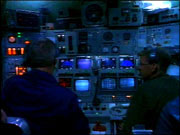 And it's an
incredibly sophisticated sonar that has a range that far exceeds any sonar I've
ever had. So it means we can see things much further away than we ever saw. And it's an
incredibly sophisticated sonar that has a range that far exceeds any sonar I've
ever had. So it means we can see things much further away than we ever saw.
NOVA: Is the difference in magnification times two, times ten?
BB: Oh, not quite ten. Certainly times five.
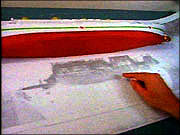 NOVA: Is side scan sonar old technology to you now by comparison? NOVA: Is side scan sonar old technology to you now by comparison?
BB: Well, I still use it. I mean the NR-1 sonar can't see amphora from Roman
ships. A side scan sonar can.
NOVA: Amphora?
BB: You know amphora? The clay jars that Roman ships carried? They were the
shipping container of the Roman Empire—sort of the 55 gallon drum of the
Roman Empire. They're commonly what the Romans tried to jettison when they
were sinking—and they help lead you to the ships. A side scan sonar can see
those, but NR-1 sonar can't. There's a classic range versus resolution issue
in underwater sonar. What you gain in range, you lose in resolution. So you
can see further, but you can only see bigger things further. And you lose the
ability to see small things. When you're looking for the Britannic, it's, you
know, big. The NR-1 is the sonar for that. But if you're looking for a clay
jar, then you need the side scan.
 NOVA: Tell us about your ROV's stereo imaging capability? How does it work
and why is it helpful? NOVA: Tell us about your ROV's stereo imaging capability? How does it work
and why is it helpful?
BB: Well, basically when you're working closely with a wreck, it's very easy
to get entangled. It's very easy to get into trouble. So the Voyager, the
Perry Tritech submersible, had stereo eyes provided by NASA Ames. And with
this vehicle system you could put on your stereo glasses and, 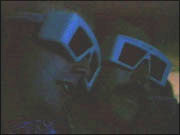 all of a sudden,
you could see in three dimensions, which made it possible to navigate through
the wreckage. And it was just like the difference between having one eye or
two eyes. You see depth perception, which is very important in dangerous
settings. It made it infinitely easier to maneuver. all of a sudden,
you could see in three dimensions, which made it possible to navigate through
the wreckage. And it was just like the difference between having one eye or
two eyes. You see depth perception, which is very important in dangerous
settings. It made it infinitely easier to maneuver.
NOVA: Can you bring us up to date on the Britannic?
BB: Well, I've just been in contact with Simon Mills, who was the historian in
the NOVA program, and he has now been awarded ownership of the Britannic.
NOVA: How did that happen?
BB: Well, he paid for it. He secured the rights.
NOVA: Who did he buy it from?
BB: He bought it from a guy named Mark Bamford who had purchased the wreck
from the British government shortly after it was discovered by Cousteau in the
late 1970's. The British Department of Trade had insured the White Star Line.
So, that's really the latest development. You know, one of our goals is to
turn the Britannic into an underwater museum, but we need to be able to deal
with an owner to do it. And now we have an owner, who's very sympathetic and
eager to go the next step.
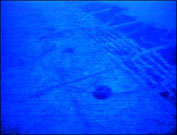 NOVA: I want to talk about your museum concept in a minute but, first—has
the Britannic site remained undisturbed, so far as you know? NOVA: I want to talk about your museum concept in a minute but, first—has
the Britannic site remained undisturbed, so far as you know?
BB: Yes, it has.
NOVA: Is there any more information on the mine versus torpedo debate?
BB: No. No one else has been out there since us. There's only been two
expeditions on the Britannic, mine and Cousteau's.
NOVA: Do you plan to explore the site further?
BB: I will downstream. I imagine I may take a look at it again when we
transit the area in the summer of 1999.
NOVA: What's happening in 1999?
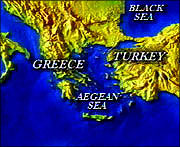 BB: We're mounting an expedition in '99 to the Black Sea to search for ancient
ships in the anaerobic oxygen-free waters of the Black Sea, where we expect to
see ships in a high state of preservation. We're going back next summer, but
we're not going to go back to the Eastern Mediterranean, we're working in the
Western Med on some Roman ships that we found. After we did the Britannic
expedition, we took the Navy NR-1 submarine down to the Mediterranean, off of
ancient Carthage, and we found three Roman ships. We're going back this next
summer to conduct the first deep water excavation ever attempted in the
Mediterranean. BB: We're mounting an expedition in '99 to the Black Sea to search for ancient
ships in the anaerobic oxygen-free waters of the Black Sea, where we expect to
see ships in a high state of preservation. We're going back next summer, but
we're not going to go back to the Eastern Mediterranean, we're working in the
Western Med on some Roman ships that we found. After we did the Britannic
expedition, we took the Navy NR-1 submarine down to the Mediterranean, off of
ancient Carthage, and we found three Roman ships. We're going back this next
summer to conduct the first deep water excavation ever attempted in the
Mediterranean.
NOVA: What kind of condition are the ships in?
BB: Oh, they're in excellent condition. They're buried in the mud and they've
been protected from wood borers by being buried in the mud. And so we're using
the nuclear submarine to excavate these three ships, and that will be the first
time it's ever been attempted.
NOVA: What are the pros and cons of our new-found ability to find these
magnificent ship wrecks?
BB: Well, it's a Pandora's box that we've opened. I mean, technology is
amoral. It has no morality. You can use nuclear technology to heat your home
or blow the human race off the face of the earth. And so all through time
technology has presented a paradox to our society. And it's society's
responsibility to determine which edge of the blade to use. Cars can kill
people or they can transport people. Airplanes can crash, they can drop bombs
or they can carry your mother to the hospital. So when one develops this kind
of technology, you've fundamentally opened up a Pandora's box in the deep sea
because, up until recently, all underwater archaeological discoveries have been
done in a water depth of less than 200 feet. Well 200 feet is less than four
percent of the world's oceans. But this new technology of submersibles and
robots can now cover ninety-seven percent of the world's oceans. And so all of
a sudden the locker has been opened. And it's a meat locker. I mean, it's
basically a preserver of history. There's probably more history now preserved
underwater than in all the museums of the world combined. And there's no law
governing that history. It's finders keepers. Who's the finder, a good guy or
a bad guy? These Roman ships that we found—now that we've found them,
someone could go out and drop bombs on them and it wouldn't be against the law.
So it's a free for all. It's the wild west. It's the absence of law. And so
what we're trying to do with the NOVA program is to raise this issue and to
sensitize people to the fact this history is down there and what's at stake.
NOVA: Let's talk about the pillaging of sites. Isn't there an argument to be
made for, let's say in the case of the Titanic, taking artifacts from the ship,
and putting them in a museum where people can see them and learn from them?
BB: The Titanic isn't a ship. It's an accident. It's a huge debris field.
The Titanic is linked to its location. When you see pairs of shoes on the
bottom of the ocean where the body landed, and those pairs of shoes are
perfectly preserved and sitting exactly relative to the body that's now
vanished, those shoes and their juxtaposition to one another, and sitting on
the floor next to the ship are a much more compelling message—a personal
message of tragedy—than some wrinkly old shoes sitting on a shelf in a
museum in Memphis, Tennessee. The technology is now here for people to visit
these sites on the Internet. You know, they're selling coal from the Titanic
on the Internet for $25 a lump. They're not going down there and saying, oh my
gosh we've got to save the ship. They're not caring about the ship. They're
bringing up artifacts for commercial gain. These people are not historians,
they're not archaeologists. They're not even people of the sea. It's a used
car salesman from Connecticut. And so the point is that there are ships of
antiquity and ships of historical importance that are not protected from
unscrupulous people.
NOVA: Can you describe your vision for an undersea museum in more detail?
 BB: Basically, we want to place cameras on the Britannic that are then
controlled from our new exhibit center in Mystic, Connecticut—but,
ultimately, can be controlled by anyone on the information highway. It's not a
great deal of technology to place permanent visitation technology on the
Britannic and have people access it just as they would go to Gettysburg. With
our JASON Project, we have children driving robots on the Internet right now.
We've had children driving robots in 9,000 feet of water on hydrothermal vents
from Liverpool, England and from Denver, Colorado in real time. And it's just
more and more as we wire up the world to where nowhere in the world will we be
more than a quarter of a second away at the speed of light. And once you
hardwire the world, then all of a sudden you have infinite, instant access to
anywhere. BB: Basically, we want to place cameras on the Britannic that are then
controlled from our new exhibit center in Mystic, Connecticut—but,
ultimately, can be controlled by anyone on the information highway. It's not a
great deal of technology to place permanent visitation technology on the
Britannic and have people access it just as they would go to Gettysburg. With
our JASON Project, we have children driving robots on the Internet right now.
We've had children driving robots in 9,000 feet of water on hydrothermal vents
from Liverpool, England and from Denver, Colorado in real time. And it's just
more and more as we wire up the world to where nowhere in the world will we be
more than a quarter of a second away at the speed of light. And once you
hardwire the world, then all of a sudden you have infinite, instant access to
anywhere.
NOVA: How far along are you with this dream?
BB: Well, we're building a $30 million dollar exhibition center in Mystic,
Connecticut that includes a facility for—we call it "live telepresence
access to habitats." And we're wiring up habitats in the Arctic, in Bermuda—I mean we're doing it. And one of them is to wire up the Britannic. Because
it's easier right now than the Titanic. I mean, the Titanic's tougher.
NOVA: Because it's deeper.
BB: Because it's deeper and more distant. But that's just more cable. I
would rather prove my concept on the Britannic.
NOVA: Is there such a thing as an unsinkable ship?
BB: Sure. One that's already sunk. No, there's no such thing.
NOVA: Why?
BB: Because anything done by man isn't perfect. The Japanese, in all great
works of art, make a mistake to make that point. We do it whether we intend to
or not.
Lost Sister Home | Unsinkable? | Explorer | Search & Salvage
Resources | Table of Contents
|
|
|